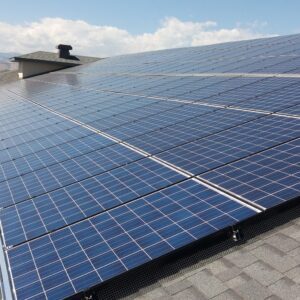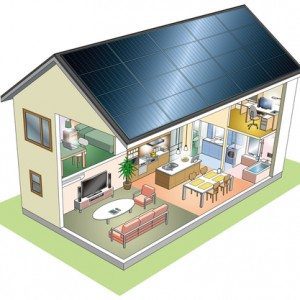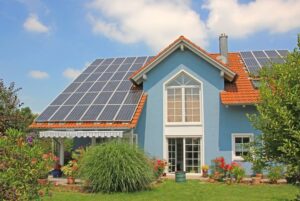 As solar energy continues to become more pervasive across society, being adopted on a wider scope at both the consumer and industrial levels, its uses and users expand by the day. In a convergence of cutting-edge solar technology and an innovative, boundary-pushing company, Google has recently announced its plans to power a new data center in the Netherlands exclusively with the electricity harnessed by a local Dutch solar farm.
By partnering with Eneco, a prominent energy provider in the Netherlands, Google will be using a clean, renewable source of unlimited energy for at least the coming decade. The new data center, housing thousands of servers to extend Google’s reach into the European marketplace, is innovative in every sense of the word, from the center’s physical design to its adoption of clean energy.
The Dutch data center is a part of the company’s commitment to drive its many different facets of operations exclusively on renewable energies by the end of 2017. To that end, Google is currently the world’s largest corporate buyer of renewable energy, now reaching 2.6 gigawatts of total renewable power between wind and solar energy providers.
As solar energy continues to become more pervasive across society, being adopted on a wider scope at both the consumer and industrial levels, its uses and users expand by the day. In a convergence of cutting-edge solar technology and an innovative, boundary-pushing company, Google has recently announced its plans to power a new data center in the Netherlands exclusively with the electricity harnessed by a local Dutch solar farm.
By partnering with Eneco, a prominent energy provider in the Netherlands, Google will be using a clean, renewable source of unlimited energy for at least the coming decade. The new data center, housing thousands of servers to extend Google’s reach into the European marketplace, is innovative in every sense of the word, from the center’s physical design to its adoption of clean energy.
The Dutch data center is a part of the company’s commitment to drive its many different facets of operations exclusively on renewable energies by the end of 2017. To that end, Google is currently the world’s largest corporate buyer of renewable energy, now reaching 2.6 gigawatts of total renewable power between wind and solar energy providers.
- Home
- Residential
- Commercial
- Tesla
- Testimonials
- About Us
- Contact Us
Category: Solar Power
 As solar energy continues to become more pervasive across society, being adopted on a wider scope at both the consumer and industrial levels, its uses and users expand by the day. In a convergence of cutting-edge solar technology and an innovative, boundary-pushing company, Google has recently announced its plans to power a new data center in the Netherlands exclusively with the electricity harnessed by a local Dutch solar farm.
By partnering with Eneco, a prominent energy provider in the Netherlands, Google will be using a clean, renewable source of unlimited energy for at least the coming decade. The new data center, housing thousands of servers to extend Google’s reach into the European marketplace, is innovative in every sense of the word, from the center’s physical design to its adoption of clean energy.
The Dutch data center is a part of the company’s commitment to drive its many different facets of operations exclusively on renewable energies by the end of 2017. To that end, Google is currently the world’s largest corporate buyer of renewable energy, now reaching 2.6 gigawatts of total renewable power between wind and solar energy providers.
As solar energy continues to become more pervasive across society, being adopted on a wider scope at both the consumer and industrial levels, its uses and users expand by the day. In a convergence of cutting-edge solar technology and an innovative, boundary-pushing company, Google has recently announced its plans to power a new data center in the Netherlands exclusively with the electricity harnessed by a local Dutch solar farm.
By partnering with Eneco, a prominent energy provider in the Netherlands, Google will be using a clean, renewable source of unlimited energy for at least the coming decade. The new data center, housing thousands of servers to extend Google’s reach into the European marketplace, is innovative in every sense of the word, from the center’s physical design to its adoption of clean energy.
The Dutch data center is a part of the company’s commitment to drive its many different facets of operations exclusively on renewable energies by the end of 2017. To that end, Google is currently the world’s largest corporate buyer of renewable energy, now reaching 2.6 gigawatts of total renewable power between wind and solar energy providers.
5 Technologies That Make Green Living Easy
Written by goldensolar on . Posted in Green Living, Solar Panels, Solar Power. Leave a Comment
 Who doesn’t want to contribute to a clean planet? Since the “Save the Planet” phase decades ago, the idea has morphed into a solid part of our global way of life. Solar panels on someone’s roof aren’t a novelty anymore; they have become everyday sightings.
Who doesn’t want to contribute to a clean planet? Since the “Save the Planet” phase decades ago, the idea has morphed into a solid part of our global way of life. Solar panels on someone’s roof aren’t a novelty anymore; they have become everyday sightings.
Why Green Living?
So, are we really pulling off this “green living” thing? With the help of the solar panel industry, which is constantly innovating and improving, pulling energy from the sun to power our homes is not only possible but is becoming more commonplace and affordable. The average household in the United States uses around 901 kilowatt hours of electricity per month, according to the US Energy Information Administration. We also use an average of about 400 gallons of water a day, some of it heated. If your home functions from a green point of view, installing at least some of the current technologies can make life so much easier.Green Technology for the Home
Technology is a beautiful thing. Whether you’re into green living 1000 percent or you just want to dabble a bit here and there, there’s an array of technological devices available to help you make your home more eco-friendly.- Solar Panel Array. Today’s solar panels aren’t the monstrosities that haunted our rooftops in the 1970s. Modern solar panels are efficient and compact and can fit seamlessly into your home’s aesthetic.
- Solar Hot Water Heater. A conventional water heater uses natural gas or electricity to heat the water for your morning shower. If you’re pulling power off the grid, that’s money down the drain. A solar hot water heater can use energy collected from your solar panels to heat the water you need.
- Rain Barrels. Whether you’re growing flowers for decoration or food for the family table, you’re not growing much without watering. For outdoor water use, a rain barrel or two makes for a fantastic irrigation system that doesn’t cost you to refill.
- Backyard Wind Turbine. If you live in an area where wind turbines are feasible, having one in your backyard can supplement your solar panels as your home’s energy source.
- Programmable Thermostat. Not only are programmable thermostats economically a good idea, they can make controlling your home’s internal temperature a stress-free affair. You can set it to control your home’s HVAC to the settings your family prefers. This can stretch your solar energy even further.
Off-Grid Freedom Is Yours
Written by goldensolar on . Posted in Green Living, Solar Power. Leave a Comment
 Going off the electrical grid can begin as an environmental or political ideal, but in practical terms, 2017 is the year to turn ideas into reality. For those brave pioneers who tried to free themselves from utility companies in years past, the available options today will seem like Utopia. While many details must be considered, your off-grid power plan needs two major components: the photovoltaic (PV) panels and the storage batteries.
Going off the electrical grid can begin as an environmental or political ideal, but in practical terms, 2017 is the year to turn ideas into reality. For those brave pioneers who tried to free themselves from utility companies in years past, the available options today will seem like Utopia. While many details must be considered, your off-grid power plan needs two major components: the photovoltaic (PV) panels and the storage batteries.
Plan
When deciding to make the leap to off-grid power, plan carefully. Calculate your power consumption needs, how many PV panels you will need to meet those needs and how many batteries (and of what type) you will require to store power for sunless days and overnight use. The first consideration is how long you expect batteries to sustain you and your family:- Overnight and cloudy days?
- Through a snowstorm of three or four days?
- Tesla Powerwall — using lithium-ion batteries for maximum efficiency
- Iron Edison — using nickel-iron batteries
- Adara — lithium-ion energy storage systems
PV Panels
PV panels can power your home’s entire ongoing needs and are the source for power storage sent to the backup batteries. In off-grid systems, the PV panels need to maximize energy collection, so you may find that rooftop panels are only a start. You may want to consider additional ground or pole mounts, or even panels that can rotate to capture as much sunlight through the day as possible.Solar Charge Controller
Getting the power from the PV panels to the batteries requires a solar charge controller. The controller acts as a sort of one-way valve, preventing battery power from running out to the panels on cloudy days and keeping the batteries fully charged by the panels during sunny days. A solar charge controller can either be a Maximum Power Point Tracking (MPPT) or Pulse Width Modulated (PWM) controller. The MPPT is superior, but more costly since it matches PV panel output to the battery bank’s capacity. A PWM controller is the more traditional, less expensive, solution.Batteries
Though called “solar batteries,” the technology behind power storage is not exclusive to solar energy. All batteries store and deliver power as Direct Current (DC), rather than the Alternating Current (AC) our everyday appliances, computers, and devices demand. This means the flow is not directly from batteries into your home; you need an inverter, or possibly even two. North American electrical current is 240 volts that are stepped down to 120 volts; some appliances (a stove, a clothes dryer) may use 240-volt AC, while everything else in your home requires 120-volt power. While some inverters can be ganged to provide 240 volts, you may find a simpler solution by creating two separate power feeds from the batteries.Professional Partner
Before embarking on an exciting adventure in off-grid living, partner with seasoned solar professionals. Contact Golden Solar today to learn more about the many facets of off-grid solar power. You can avoid costly mistakes by tapping the knowledge and experience of the experts at Golden Solar. The post Off-Grid Freedom Is Yours appeared first on Golden Solar.Solar Panels to Cut Energy Bills for Some Low-Income Coloradans
Written by goldensolar on . Posted in Solar Power. Leave a Comment
 Though the average person’s utility bill has steadily increased over the years, wages have not improved at anywhere near the same pace. The solution to our utility bill woes might be found in the form of solar power. Though solar power is often characterized as extremely costly and somewhat ineffective, it has the potential to wean humans off of our reliance on finite and highly polluting fossil fuels. Government initiatives to promote solar power like the one currently administered by the Colorado Energy Office just might be exactly what we need to make the transition from fossil fuels to the comparably green solar power.
How Colorado is Using Solar Power to Decrease Utility Bills
Some low-income households in Colorado are eligible for the installation of solar panels through a new initiative administered by the state’s Energy Office known as the Weatherization Program. This program is operated on the federal level by the United States Department of Energy and implemented through local energy offices on the state level. Solar panel installation is one component of the initiative. The Weatherization Program also provides LED light bulbs, “green” refrigerators that operate at a heightened efficiency, improved insulation and storm windows.
Though the average person’s utility bill has steadily increased over the years, wages have not improved at anywhere near the same pace. The solution to our utility bill woes might be found in the form of solar power. Though solar power is often characterized as extremely costly and somewhat ineffective, it has the potential to wean humans off of our reliance on finite and highly polluting fossil fuels. Government initiatives to promote solar power like the one currently administered by the Colorado Energy Office just might be exactly what we need to make the transition from fossil fuels to the comparably green solar power.
How Colorado is Using Solar Power to Decrease Utility Bills
Some low-income households in Colorado are eligible for the installation of solar panels through a new initiative administered by the state’s Energy Office known as the Weatherization Program. This program is operated on the federal level by the United States Department of Energy and implemented through local energy offices on the state level. Solar panel installation is one component of the initiative. The Weatherization Program also provides LED light bulbs, “green” refrigerators that operate at a heightened efficiency, improved insulation and storm windows.
Solar Power’s Expansion Through the Weatherization Program
The Weatherization Program’s first rooftop solar panel was recently placed on a low-income home in Colorado Springs. Rooftop solar has the potential to double each low-income household’s energy savings. Representatives from Colorado’s Energy Office stated that their aim is to add solar panels to at least 100 low-income houses throughout Colorado every year. The addition of these solar panels is meant to shed light on the under-publicized benefits of solar power. At the moment, many homeowners and business owners do not even consider the purchase of solar panels as the technology has been stereotyped as absurdly expensive. Though the up-front cost of solar panels intimidates some prospective buyers, these amazing pieces of technology pay for themselves as time progresses. Government initiatives like the Weatherization Program are designed to heighten awareness of solar power’s extensive merits in terms of cost savings as well as reducing our negative impact on the environment. For one, the addition of solar panels to low-income homes lowers the total energy burden as it reduces the cost to power and heat living spaces. These solar panels also serve to boost opportunities to distribute any surplus of solar energy that is collected and not used by the residents of the low-income homes where the panels have been installed. Perhaps most importantly, the program’s solar panels are a highly publicized example of solar power’s viability as a power source.Learn More About The Benefits of Solar Power
If you would like to learn more about the Weatherization Program, its guidelines and how the Colorado Energy Office is implementing the push for solar power, click the following link: https://www.colorado.gov/pacific/energyoffice/weatherization-faqsIs Solar Energy Really Too Expensive?
Written by goldensolar on . Posted in Solar Power. Leave a Comment
When the topic of solar power comes up, many quickly dismiss it as being too expensive. Yet the alternative to solar power is the continued burning of fossil fuels. Fossil fuels are limited and their incineration is devastating our sensitive environment. We are at a crossroads: Find ways to make solar power more affordable or march forth with the poisoning of our planet through the burning of fossil fuels.
Can we put a Price Tag on Earth?
Building, selling and placing solar panels on rooftops is not a cheap endeavor. Yet we might not have any other choice as our finite fossil fuels continue to dwindle and we add even more nasty pollution to our air, water and land. Our engineers and physicists must figure out how to further lower the cost of solar panels. This will prove to be somewhat challenging as utility companies have united to lobby politicians against the continued expansion of rooftop solar initiatives. Making the push for solar power expansion even more difficult is the fact that solar panels often takes years to produce a pay-off. Although almost all photovoltaic systems do eventually pay back their cost and more. Those who live in especially sunny areas of the world stand a much greater chance at profiting from solar power than those in areas with comparably overcast skies. Yet many individuals and organizations can’t even afford a single solar panel. Such a beleaguered financial situation makes it impossible to generate income from solar panels in the long-run. The question looms: Can we, in good conscience, put a price tag on our planet? It appears as though utility executives are buying and selling our politicians left and right. What are the odds that these politicians will support initiatives to reduce the cost of solar power or create solar power rebates/tax incentives? The odds are quite low at the moment.Millennials are Renting and That’s Ominous News for the Solar Power Push
If the United States had a burgeoning middle class, plenty more homeowners would consider adding solar panels to their property. The economy never fully recovered from the recession of 2008. Though baby-boomers own their fair share of homes, most millennials rent. Saddled by crushing student debt and shaky employment prospects, millennials have become increasingly hesitant to take on a home mortgage. This fact does not bode well for the future of solar power. Renters cannot install solar panels on a landlord’s property. As a result, few millennials even ponder the notion of installing solar panels. Landlords have no incentive to install solar panels as the savings would go straight into tenants’ pockets.An Increase in Solar Power Incentives is Necessary
In the long run, a continued reliance on fossil fuels does not benefit humanity or our delicate planet. Federal and state government officials must band together to craft far-reaching legislation that incentivizes the purchase of solar panels. These incentives will reduce solar panel costs for homeowners as well as businesses and even government agencies themselves. The alternative is to watch our planet melt one day at a time.









